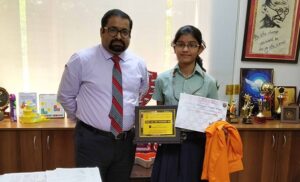Download our FREE Academic Calendar now! 📚 Start your child’s journey to success.
Dr. Maria Montessori’s educational innovation, known as the Montessori method, has earned extensive acclaim due to its distinctive approach to cultivating independent learners. Central to Montessori philosophy is the conviction that children inherently possess curiosity and the ability to guide their own learning journey. In order to provide a setting where pupils can develop their independence, the Montessori teacher is essential.
In this blog post, we’ll examine the critical part Montessori educators play in fostering self-directed learning and deciding the intellectual development of young minds.
What is the Montessori Curriculum?
The Montessori curriculum is a child-centred, active learning approach to education. The fundamental assumption of it is that young infants are by nature curious and receptive to learning. Through the curriculum, students have the opportunity to focus on gaining independence, taking responsibility for their mistakes, and showing respect for others and the environment.
Key components of the Montessori curriculum
1. Child-Centred Learning: In a Montessori classroom, the curriculum is tailored to the individual needs and interests of each child. This method allows kids to learn at their own pace while acknowledging that they have a variety of learning preferences and skills.
2. Mixed-Age Groups: Montessori classrooms typically consist of mixed-age groups, which fosters collaboration and mentorship among students. Older children often help younger ones, reinforcing their own knowledge and leadership skills.
3. Hands-On Learning: The Montessori curriculum places a strong emphasis on hands-on, experiential learning. Materials and activities are meticulously created to be self-correcting, allowing children to explore and learn on their own via inquiry and experimenting.
H2: How Does the Montessori Curriculum Work?
The Montessori curriculum operates on a unique and highly effective approach that differs significantly from traditional educational methods. It is designed to harness the natural curiosity and intrinsic motivation of children. Here is a detailed description of how the Montessori approach works:
1. Multi-Age Classrooms: Montessori classrooms often feature students of varying ages. Younger children learn from older peers, and older students reinforce their knowledge by teaching younger ones. This creates a collaborative atmosphere, where mentorship and cooperation are nurtured.
2. Child-Centred Learning: In Montessori, students have the freedom to choose their activities based on their interests. This approach sparks intrinsic motivation, as children naturally engage with subjects that captivate them, driving a deeper understanding and enthusiasm for learning.
3. Hands-On Materials: The Montessori curriculum relies on tactile, self-correcting materials. These materials encourage experiential learning, as students manipulate objects to grasp abstract concepts, and they provide immediate feedback, allowing students to correct errors independently.
4. Freedom Within Limits: While students have the freedom to choose activities and work at their own pace, clear boundaries set by the teacher ensure a structured environment. This balance empowers students to make responsible choices and develop self-discipline.
Role of the Montessori Teacher
In the Montessori classroom, the teacher:
1. Guides Learning: Serves as a facilitator, not a lecturer, allowing students to explore subjects at their own pace, providing guidance only when needed, and fostering a sense of curiosity.
2. Prepares the Environment: Thoughtfully arrange the classroom to stimulate curiosity and independence. Materials are meticulously organised, making them easily accessible to students and inviting exploration.
3. Values Individuality: Recognises and respects the various needs and learning styles of every child, and adapts instruction to take these into account. All students will experience a personalised learning process thanks to this strategy.
4. Encourages Independence: Encourages independence by imparting useful life skills such as time management, self-care, and decision-making. Giving students the freedom to decide within the boundaries established encourages responsibility.
5. Observes and Assesses: Continuously observes and assesses students’ progress, understanding that every child is on a unique developmental path. These observations inform the teacher’s instruction, ensuring that it aligns with each student’s readiness and interests.
6. Fosters Order and Respect: Establishes a classroom culture of order and respect, where students learn to respect one another, the environment, and the learning materials. This creates a harmonious and productive atmosphere.
5 Advantages of Montessori Curriculum in Noida Schools
Montessori education has gained popularity in Noida, as it offers several advantages for young learners. Here are five key benefits of implementing the Montessori curriculum in schools in Noida:
1. Individualised Learning: In Noida Montessori schools, the curriculum is tailored to the unique needs and interests of each child. This individualised approach ensures that students can progress at their own pace, whether they need additional support or are ready for more advanced challenges. This flexibility in learning accommodates the diverse student population in Noida.
2. Hands-On Learning: Montessori materials are designed to be hands-on and engaging. They encourage students to explore, manipulate, and interact with the concepts they are learning. This kinaesthetic approach not only enhances understanding but also fosters a love for learning among Noida students.
3. Cultivating Independence: Noida Montessori schools emphasise independence and self-sufficiency from an early age. Students learn practical life skills, such as cleaning, cooking, and organising, which are valuable for their personal development. This focus on independence prepares students for success in both academics and life beyond school.
4. Holistic Development: Montessori education in Noida schools recognizes that a child’s development extends beyond academics. It places equal importance on nurturing social and emotional intelligence. Students learn to collaborate, communicate effectively, and develop strong interpersonal skills, which are essential for success in today’s interconnected world.
5. Smooth Transition to Mainstream Education: Many Noida schools offer programs that seamlessly transition students into mainstream educational systems. This ensures that students who start their educational journey in a Montessori environment can adapt well to other schooling models when necessary, providing them with a solid foundation for future academic endeavours.
Conclusion
In Noida’s international schools, the Montessori curriculum shines as a beacon of excellence. It offers individualised learning, hands-on engagement, independence, holistic development, and smooth transitions to mainstream education. This approach is especially valuable in diverse international school settings, nurturing adaptable, culturally aware students prepared for a globalised world. In Noida, the Montessori curriculum elements in international schools represent a commitment to providing top-tier education.
Frequently Asked Questions (FAQs) about Montessori Education
1. What is the role of a teacher in fostering the development of the learner?
The teacher in a Montessori classroom serves as a guide and facilitator of learning. They observe each child’s progress, tailor instruction to individual needs, and create a prepared environment that encourages exploration and independence. The teacher’s role is to nurture the child’s natural curiosity, provide guidance, and support holistic development.
2. How do you foster independence in your child in Montessori?
Fostering independence in a Montessori environment involves providing opportunities for self-directed learning and life skills. Teachers offer choices within boundaries, encourage decision-making, and teach practical life skills like dressing, cleaning, and cooking. Allowing kids to learn from their experiences and failures fosters independence.
3. What is the role of the teacher in a Montessori class?
The teacher is essential to setting up a prepared environment, monitoring student development, and facilitating individualised learning journeys in a Montessori classroom. They introduce materials, offer lessons when appropriate, and act as a resource for students. The teacher’s focus is on supporting the child’s natural desire to learn and grow.
4. What is the basic aim of education in Montessori?
The fundamental aim of education in Montessori is to nurture the holistic development of each child. This includes fostering intellectual, social, emotional, and physical growth. Montessori education seeks to cultivate independent, self-motivated learners who are well-prepared for lifelong learning and responsible citizenship in a global community.



































